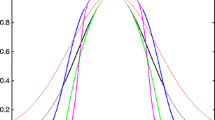Abstract
Sympatric speciation, the origin of two or more species from a single local population, has almost certainly been involved in formation of several species flocks1,2,3,4, and may be fairly common in nature5. The most straightforward scenario for sympatric speciation requires disruptive selection favouring two substantially different phenotypes, and consists of the evolution of reproductive isolation between them followed by the elimination of all intermediate phenotypes6. Here we use the hypergeometric phenotypic model7,8,9,10 to show that sympatric speciation is possible even when fitness and mate choice depend on different quantitative traits, so that speciation must involve formation of covariance between these traits. The increase in the number of variable lociaffecting fitness facilitates sympatric speciation, whereas the increase in the number of variable loci affecting mate choice has the opposite effect. These predictions may enable more cases of sympatric speciation to be identified.



Similar content being viewed by others
References
Mina, M. V., Mironovsky, A. N. & Dgebuadze, Y. Y. Lake Tana large barbs: phenetics, growth and diversification. J. Fish Biol. 48, 383–404 (1996).
Berrebi, P. & Valiushok, D. Genetic divergence among morphotypes of Lake Tana (Ethiopia) barbs. Biol. J. Linn. Soc. 64, 369–384 (1998).
Schliewen, U. K., Tautz, D. & Paabo, S. Sympatric speciation suggested by monophyly of crater lake cichlids. Nature 368, 629–632 (1994).
Johnson, T. C.et al. Late pleistocene desiccation of Lake Victoria and rapid evolution of cichlid fishes. Science 273, 1091–1093 (1996).
Ritchie, M. G. & Phillips, S. D. F. in Endless Forms: Species and Speciation (eds Howard, D. J. & Berlocher, S. H.) 291–308 (Oxford Univ. Press, New York, 1998).
Kondrashov, A. S. & Mina, M. V. Sympatric speciation: when is it possible? Biol. J. Linn. Soc. 27, 201–223 (1986).
Kondrashov, A. S. On the intensity of selection for reproductive isolation at the beginnings of sympatric speciation. Genetika 20, 408–415 (1984).
Barton, N. H. On the spread of new gene combinations in the third phase of Wright's shifting-balance. Evolution 46, 551–557 (1992).
Doebeli, M. Aquantitative genetic competition model for sympatric speciation. J. Evol. Biol. 9, 893–909 (1996).
Shpak, M. & Kondrashov, A. S. Applicability of the hypergeometric phenotypic model to haploid and diploid populations. Evolution 53, 600–604 (1999).
Darwin, C. The Origin of Species by Means of Natural Selection (Murray, London, 1859).
Kondrashov, A. S. & Shpak, M. On the origin of species by means of assortative mating. Proc. R. Soc. Lond. B 265, 2273–2278 (1998).
Wallace, A. R. Darwinism. (Macmillan, London, 1889).
Rice, W. R. Disruptive selection of habitat preference and the evolution of reproductive isolation: asimulation study. Evolution 38, 1251–1260 (1984).
Kondrashov, A. S. Multilocus model of sympatric speciation. III. Computer simulations. Theor. Popul. Biol. 29, 1–15 (1986).
Maynard Smith, J. Sympatric speciation. Am. Nat. 100, 637–650 (1966).
Rice, W. R. & Hostert, E. E. Laboratory experiments on speciation: what have we learned in 40 years? Evolution 47, 1637–1653 (1993).
Kondrashov, A. S., Yampolsky, L. Yu. & Shabalina, S. A. in Endless Forms: Species and Speciation (eds Howard, D. J. & Berlocher, S. H.) 90–98 (Oxford Univ. Press, New York, 1998).
Felsenstein, J. Skepticism towards Santa Rosalia, or why are there so few kinds of animals? Evolution 35, 124–138 (1981).
Karlin, S. General two-locus selection models: some objectives, results and interpretations. Theor. Popul. Biol. 7, 364–398 (1975).
Turner, G. F. & Burrows, M. T. Amodel of sympatric speciation by sexual selection. Proc. R. Soc. Lond. B 260, 287–292 (1995).
Galis, F. & Metz, J. A. J. Why are there so many cichlid species? Trends Ecol. Evol. 13, 1–2 (1998).
van Doorn, G. S., Noest, A. J. & Hogeweg, P. Sympatric speciation and extinction driven by environment dependent sexual selection. Proc. R. Soc. Lond. B 265, 1915–1919 (1998).
Axelrod, H. R. The Most Complete Colored Lexicon of Cichlids (TFH Publications, Neptune City, 1996).
Seehausen, O., van Alphen, J. J. M. & Witte, F. Cichlid fish diversity threatened by eutrophication that curbs sexual selection. Science 277, 1808–1811 (1997).
Seehausen, O. & van Alphen, J. J. M. The effect of male coloration on female mate choice in closely related Lake Victoria cichlids (Haplochromis nyererei complex). Behav. Ecol. Sociobiol. 42, 1–8 (1998).
Lewontin, R. C., Kirk, D. & Crow, J. F. Selective mating, assortative mating and inbreding: definitions and implications. Eugen. Quart. 15, 141–143 (1966).
Acknowledgements
This study was supported by a grant from the NSF.
Author information
Authors and Affiliations
Corresponding author
Rights and permissions
About this article
Cite this article
Kondrashov, A., Kondrashov, F. Interactions among quantitative traits in the course of sympatric speciation. Nature 400, 351–354 (1999). https://doi.org/10.1038/22514
Received:
Accepted:
Issue Date:
DOI: https://doi.org/10.1038/22514
- Springer Nature Limited
This article is cited by
-
Ecological disruptive selection acting on quantitative loci can drive sympatric speciation
npj Systems Biology and Applications (2024)
-
Divergent preference functions generate directional selection in a jumping spider
Scientific Reports (2023)
-
The complex genetic architecture of male mate choice evolution between Drosophila species
Heredity (2020)
-
Genetic relationships of cichlid fishes from Lake Malawi based on mitochondrial DNA sequences
Limnology (2020)
-
Selection for background matching drives sympatric speciation in Wall Gecko
Scientific Reports (2019)





